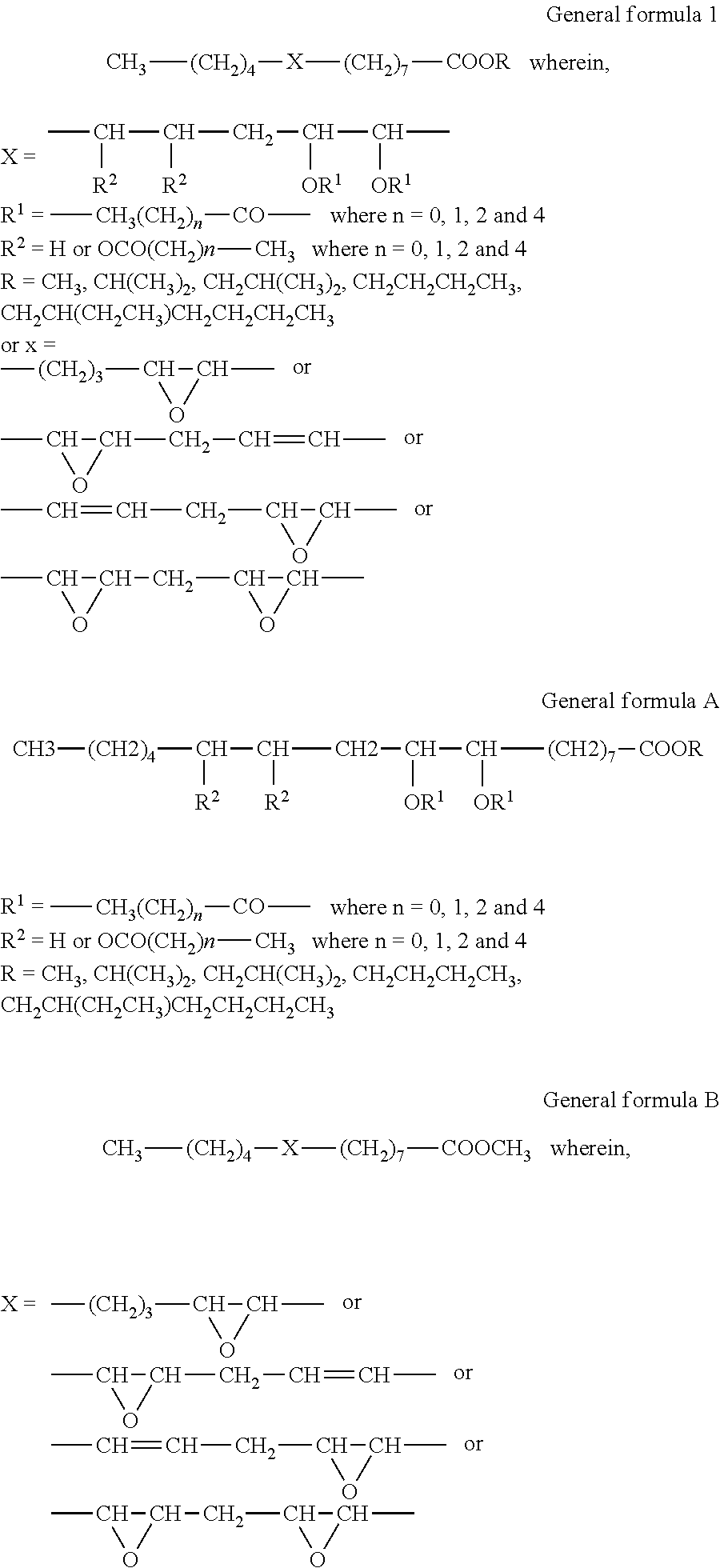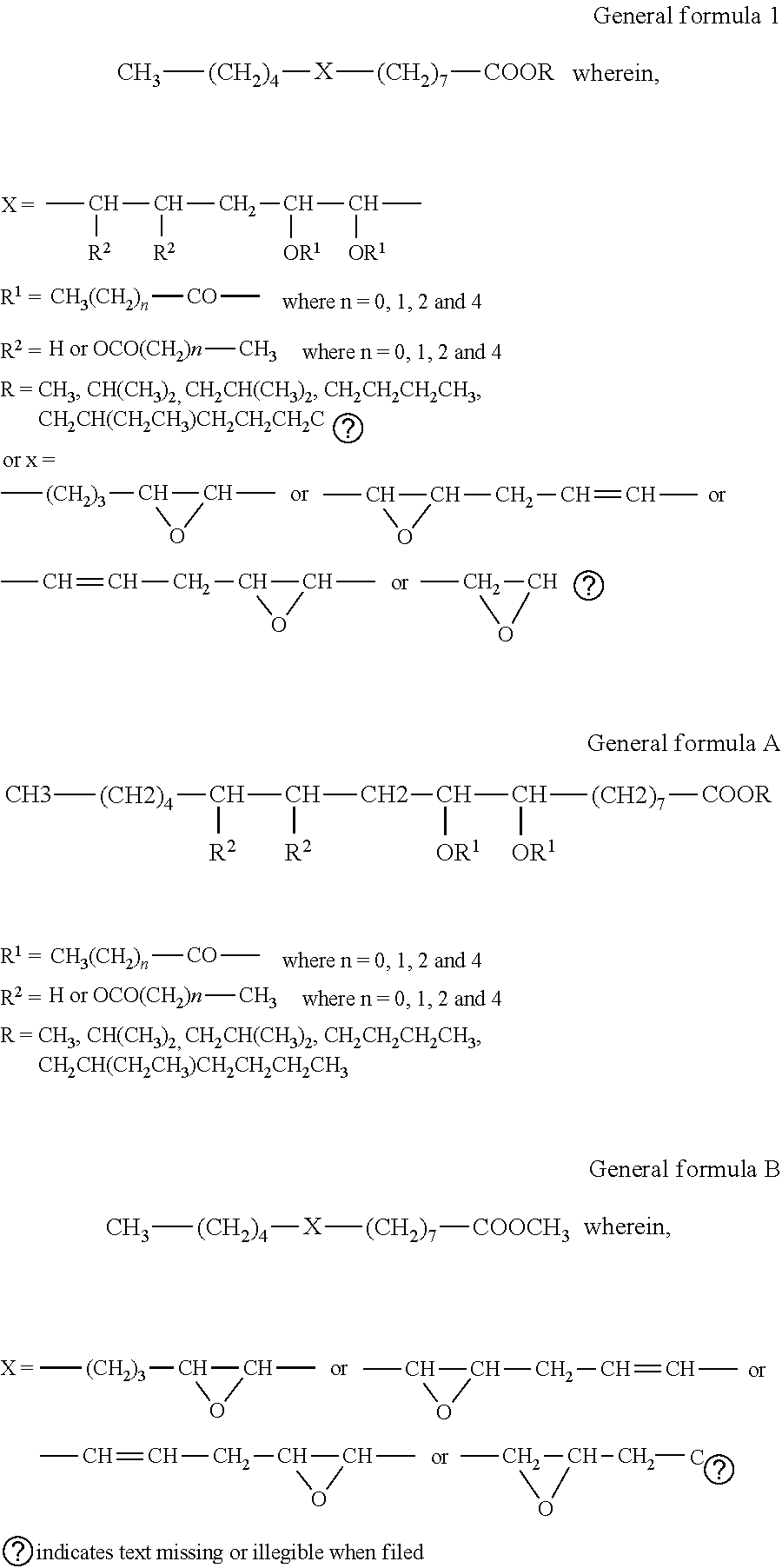Process for the preparation of karanja oil-based epoxy and acyloxy compounds as lubricant basestocks
a technology of acyloxy compounds and karanja oil, which is applied in the direction of fatty acid chemical modification, fatty acid oxidation, organic chemistry, etc., can solve the problems of indirect burden on the food sector, poor oxidation and low temperature stability, and recent restrictions on the use of chlorinated compounds as lubricants
- Summary
- Abstract
- Description
- Claims
- Application Information
AI Technical Summary
Benefits of technology
Problems solved by technology
Method used
Image
Examples
example 1
Preparation of Karanja Fatty Acid Methyl Esters
[0043]Karanja oil (200 g, 0.2 mol) and sodium hydroxide (2 g, 1 wt % of substrate) dissolved in methanol (48 ml, 1.2 mol) were taken into a three neck RB flask and refluxed at 70° C. under constant mechanical stirring for 4 hr. The formation of methyl esters was monitored by TLC eluted with hexane / ethyl acetate, 90 / 10 (vol / vol). The weight of the product was 159.8 g (90%).
example 2
Preparation of Epoxy Karanja Fatty Acid Methyl Esters and Evaluation of Lubricant Properties
[0044]KFAME (100 g, 0.34 mol) and formic acid (19.7 ml, 0.51 mol) and sulfuric acid (1.5 ml, 2% weight of HCOOH and hydrogen peroxide) were taken into a three necked round bottomed flask and the temperature of the medium was maintained at 15° C. Hydrogen peroxide solution, 30% concentration (104.1 ml, 1.02 mol) was added slowly to the contents under mechanical stirring at 15° C. for duration of 1 hr. After addition the contents were stirred at 60° C. for 5 hr. The product was extracted hourly with ethyl acetate and washed with water until it was acid free. The obtained product was monitored by iodine value, oxirane value and gas chromatography studies. Epoxidation with an O.V 3.6 and I.V 5.4 was obtained in 1 hr. As the reaction continued, a decrease in O.V was observed. The weight of the product was 99.5 g. The formation of epoxide was confirmed by GC, GC-MS, NMR and IR spectral studies.
[004...
example 3
Preparation of Hydroxy Karanja Fatty Acid Methyl Esters
[0049]Karanja fatty acid methyl esters (100 g, 0.34 mol), formic acid (19.7 ml, 0.51 mol) and concentrated sulphuric acid (1.5 ml, 2% weight of formic acid and hydrogen peroxide) were taken into a three necked round bottomed flask and the temperature of the medium was maintained at 15° C. Hydrogen peroxide solution, 30% concentration (104.1 ml, 1.02 mol) was added slowly to the contents under mechanical stirring at 15° C. for a duration of 1 hr. After addition the contents were stirred at 60° C. for 1 hr and at 85° C. for 6 hr. The final product was extracted with ethyl acetate and washed with water until it was acid free. The weight of the product was 101.8 g. The reaction was monitored hourly by oxirane value, hydroxyl value, IR and gas chromatography studies. Hydroxylation with an H.V 155 was obtained in 7 hr. As the reaction continued, a constant HV was observed until 15 hr. The formation of hydroxyl product was confirmed by...
PUM
| Property | Measurement | Unit |
|---|---|---|
| temperature | aaaaa | aaaaa |
| temperature | aaaaa | aaaaa |
| temperature | aaaaa | aaaaa |
Abstract
Description
Claims
Application Information
 Login to View More
Login to View More - R&D
- Intellectual Property
- Life Sciences
- Materials
- Tech Scout
- Unparalleled Data Quality
- Higher Quality Content
- 60% Fewer Hallucinations
Browse by: Latest US Patents, China's latest patents, Technical Efficacy Thesaurus, Application Domain, Technology Topic, Popular Technical Reports.
© 2025 PatSnap. All rights reserved.Legal|Privacy policy|Modern Slavery Act Transparency Statement|Sitemap|About US| Contact US: help@patsnap.com



